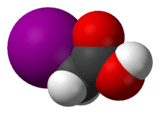Iodoacetic acid
Iodoacetic acid is a derivative of acetic acid. It is a toxic compound, because, like many alkyl halides, it is an alkylating agent.
 | |
 | |
| Names | |
|---|---|
| Preferred IUPAC name
Iodoacetic acid | |
| Other names
2-Iodoacetic acid | |
| Identifiers | |
3D model (JSmol) |
|
| ChEBI | |
| ChEMBL | |
| ChemSpider | |
| ECHA InfoCard | 100.000.537 |
PubChem CID |
|
| UNII | |
CompTox Dashboard (EPA) |
|
| |
| |
| Properties | |
| C2H3IO2 | |
| Molar mass | 185.948 g·mol−1 |
| Melting point | 81 °C (178 °F; 354 K) |
| Boiling point | 208 °C (406 °F; 481 K) |
| Hazards | |
| Safety data sheet | Oxford MSDS |
EU classification (DSD) (outdated) |
Toxic (T); Corrosive (C) |
Except where otherwise noted, data are given for materials in their standard state (at 25 °C [77 °F], 100 kPa). | |
| Infobox references | |
It reacts with cysteine residues in proteins. It is often used to modify SH-groups to prevent the re-formation of disulfide bonds after the reduction of cystine residues to cysteine during protein sequencing.
Peptidase inhibitor
Iodoacetate is an irreversible inhibitor of all cysteine peptidases, with the mechanism of inhibition occurring from alkylation of the catalytic cysteine residue (see schematic). In comparison with its amide derivative, iodoacetamide, iodoacetate reacts substantially slower. This observation appears contradictory to standard chemical reactivity, however the presence of a favourable interaction between the positive imidazolium ion of the catalytic histidine and the negatively charged carboxyl-group of the iodoacetic acid is the reason for the increased activity of iodoacetamide.[1]
Possible cancer therapy
Several studies have shown iodoacetate has anti-tumor effects. In 2002 Dr. Fawzia Fahim showed that "a single IAA treatment of tumor-bearing mice significantly increased the levels of plasma lactate dehydrogenase (LDH) activity, while it also significantly decreased the levels of plasma glucose and liver total protein, RNA and DNA, compared to normal controls."[2] In 1975 Melvin S. Rhein, Joyce A. Filppi and Victor S. Moore showed that iodoacetate improved the immune response of bone marrow.[3] In 1966 Charles A. Apffel, Barry G. Arnason & John H. Peters showed anti-tumor activity for iodoacetate.[4]
As a disinfection by-product
Iodide is a naturally occurring ion that can be found in many source waters and it is easily oxidized by wastewater disinfectants. One of the products of iodide oxidation is hypoiodous acid (HOI or OI−) which is capable of reacting with background organic materials to generate iodinated disinfection by-products (DBPs) including iodoacetic acid. In a study performed by Plewa, et al., IAA was determined to be one of the most cytotoxic of those studied, with a median lethal dose on the order of magnitude of 10−5 M. It was the most genotoxic of more than 60 DBPs studied and is the most genotoxic DBP identified thus far.[5] Iodoacetic acid has exhibited traits indicating it as a potential carcinogen, however, it has not been proven to be carcinogenic.[6] The trend continues in teratogenicity, with iodoacetic acid’s potency surpassing that of its brominated and chlorinated analogs.[7] Its toxicity correlates to its ability as an alkylating agent, which will modify cysteine residues in proteins.[8] Monohaloacetic acids are the most toxic, with toxicity increasing with halogen size. Iodoacetic acid is more toxic than bromoacetic acid and much more toxic than chloroacetic acid.[9]
See also
References
- Polgár, L. (1979). "Deuterium isotope effects on papain acylation. Evidence for lack of general base catalysis and for enzyme-leaving group interaction". European Journal of Biochemistry. 98 (2): 369–374. doi:10.1111/j.1432-1033.1979.tb13196.x. PMID 488108.
- Fahim, F. A.; Esmat, A. Y.; Mady, E. A.; Ibrahim, E. K. (2003). "Antitumor Activities of Iodoacetate and Dimethylsulphoxide Against Solid Ehrlich Carcinoma Growth in Mice". Biological Research. 36 (2): 253–262. doi:10.4067/S0716-97602003000200015. PMID 14513720.
- Rhein, M. S.; Filppi, J. A.; Moore, V. S. (1975). "Effect of Iodoacetate on the Bone Marrow Immunocompetence of AKR Mice" (PDF). Cancer Research. 35 (6): 1514–1519. PMID 1093673.
- Apffel, C. A.; Arnason, B. G.; Peters, J. H. (1966). "Induction of tumour immunity with tumour cells treated with iodoacetate". Nature. 209 (5021): 694–696. Bibcode:1966Natur.209..694A. doi:10.1038/209694a0. PMID 5922128.
- Plewa, Michael J.; Wagner, Elizabeth D.; Richardson, Susan D.; Thruston, Alfred D., Jr.; Woo, Yin-Tak; McKague, A. Bruce (2004). "Chemical and Biological Characterization of Newly Discovered Iodoacid Drinking Water Disinfection Byproducts". Environmental Science & Technology. 38 (18): 4713–4722. Bibcode:2004EnST...38.4713P. doi:10.1021/es049971v.
- Wei, Xiao; Wang, Shu; Zheng, Weiwei; Wang, Xia; Liu, Xiaolin; Jiang, Songhui; Pi, Jingbo; Zheng, Yuxin; He, Gengsheng; Qu, Weidong (2013). "Drinking Water Disinfection Byproduct Iodoacetic Acid Induces Tumorigenic Transformation of NIH3T3 Cells". Environmental Science & Technology. 47 (11): 5913–5920. Bibcode:2013EnST...47.5913W. doi:10.1021/es304786b. PMID 23641915.
- Richard, Ann M.; Hunter, E. Sidney, III (1996). "Quantitative Structure-Activity Relationships for the Developmental Toxicity of Haloacetic Acids in Mammalian Whole Embryo Culture". Teratology. 53 (6): 352–360. doi:10.1002/(SICI)1096-9926(199606)53:6<352::AID-TERA6>3.0.CO;2-1. PMID 8910981.
- "Product #35603". Thermo Scientific. Pierce Protein Biology Products.
- Richardson, Susan D.; Plewa, Michael J.; Wagner, Elizabeth D.; Shoeny, Rita; DeMarini, David M (2007). "Occurrence, genotoxicity, and carcinogenicity of regulated and emerging disinfection by-products in drinking water: A review and roadmap for research". Mutation Research. 636 (1–3): 178–242. doi:10.1016/j.mrrev.2007.09.001. PMID 17980649.
Further reading
- Knap, A. K.; Pratt, R. F. (1991). "Inactivation of the RTEM-1 cysteine beta-lactamase by iodoacetate. The nature of active-site functional groups and comparisons with the native enzyme". Biochemical Journal. 273 (1): 85–91. PMC 1149883. PMID 1989590.
- Dickens, F. (1933). "Interaction of halogenacetates and SH compounds. The reaction of halogenacetic acids with glutathione and cysteine. The mechanism of iodoacetate poisoning of glyoxalase". Biochemical Journal. 27 (4): 1141–1151. PMC 1253000. PMID 16745202.
External links
- The MEROPS online database for peptidases and their inhibitors: Iodoacetate